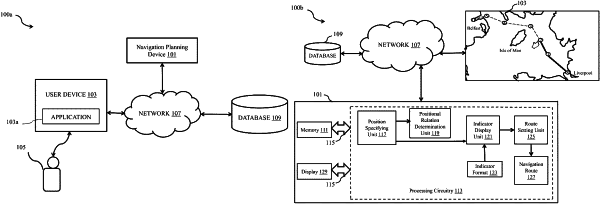| CPC G01C 21/3415 (2013.01) [G01C 21/3605 (2013.01); G06F 3/0488 (2013.01)] | 19 Claims |

|
1. A navigation planning device comprising:
starting and destination point receiving terminal configured to receive a navigation start point and a navigation destination point for a navigation route of a vessel or an aircraft;
waypoint receiving terminal configured to receive a plurality of waypoints between the navigation start point and the navigation destination point;
processing circuitry configured to:
determine a positional relationship between the plurality of waypoints, wherein the plurality of waypoints is received in one type of order, and wherein the one type of order comprises a random order or a sequential order;
determine at least one indicator data corresponding to at least one waypoint data of the plurality of waypoints, based on the positional relationship between the plurality of waypoints; and
output the at least one waypoint data and the corresponding at least one indicator data for the navigation route, to a display for displaying the at least one waypoint data and the corresponding at least one indicator data,
wherein a first orientation associated with the display of a first indicator data is determined based on the positional relationship between a first waypoint and a second waypoint;
a second orientation associated with the display of a second indicator data is determined based on the positional relationship between the second waypoint and a third waypoint; and
when a candidate position of the second waypoint is moved, the first orientation and the second orientation are changed, simultaneously, based on the movement of the candidate position of the second waypoint.
|